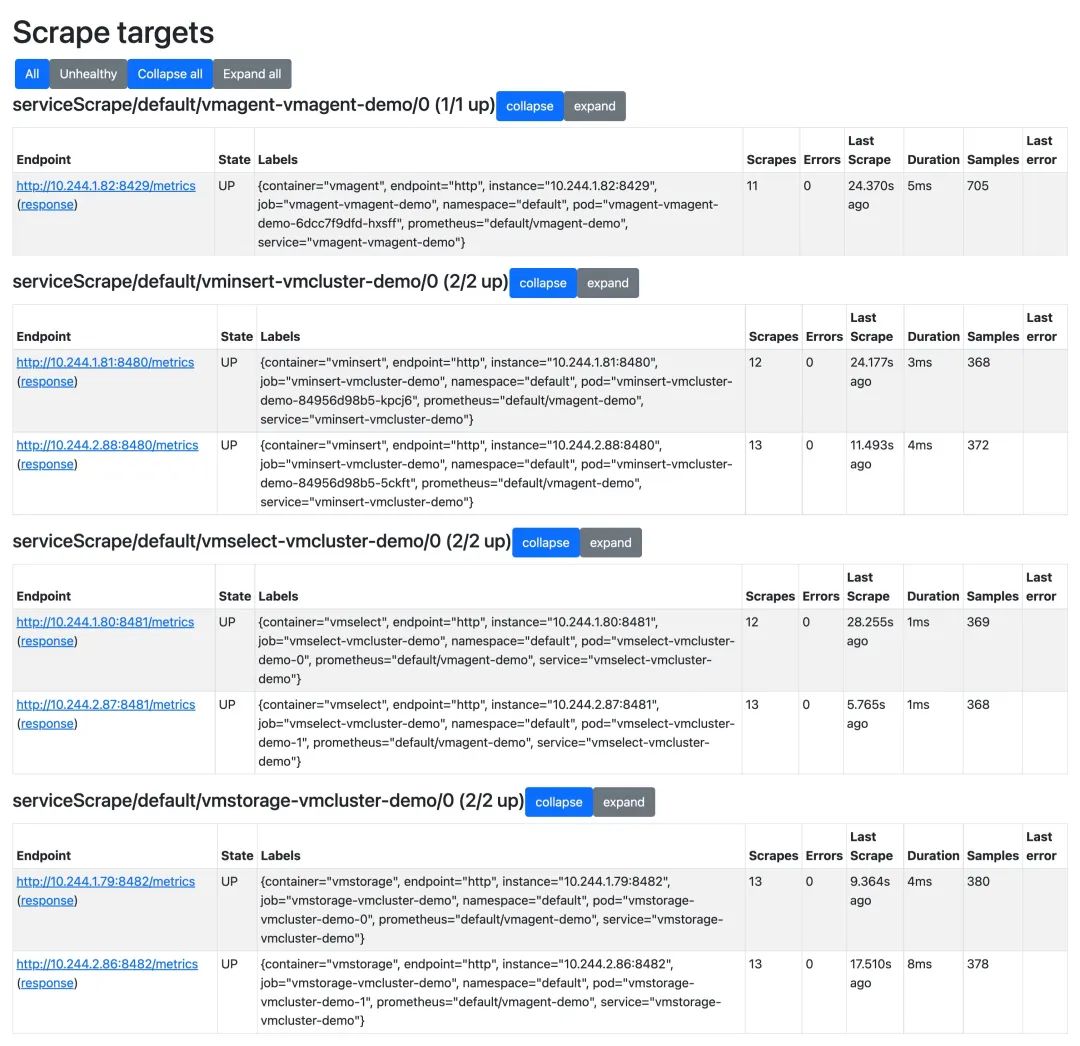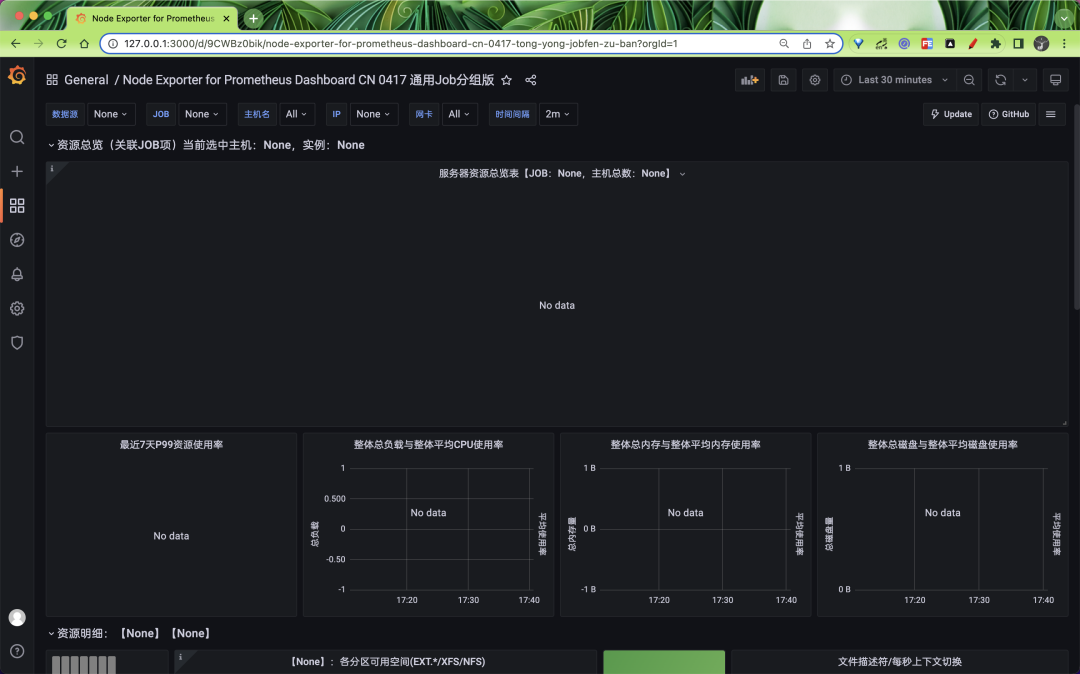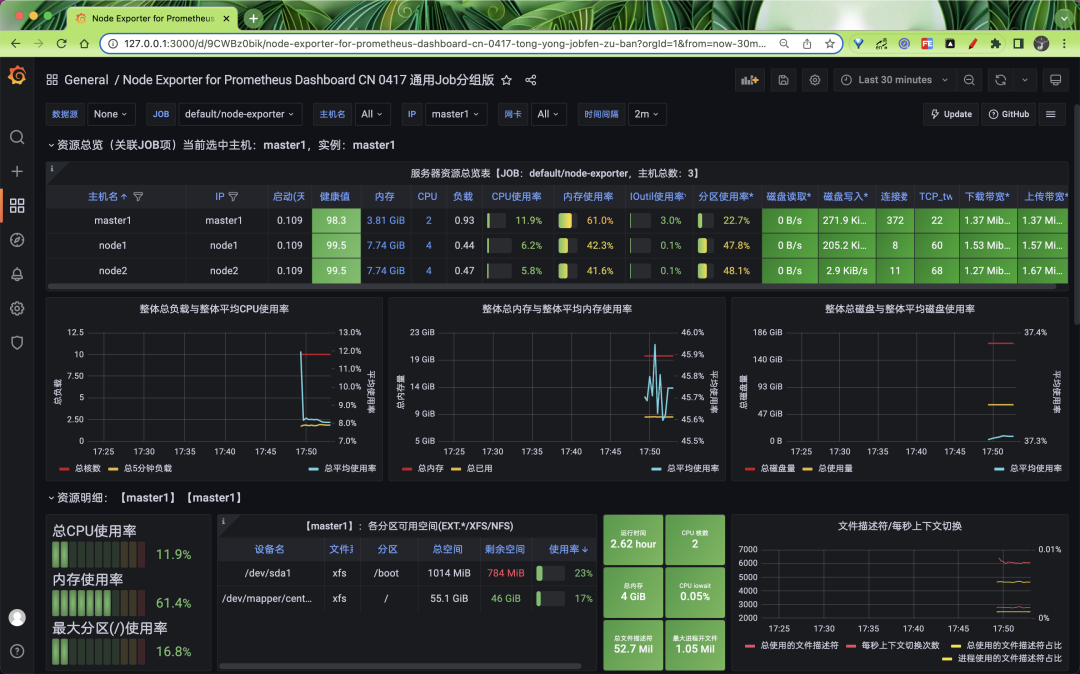
Operator 我们知道是 Kubernetes 的一大杀器,可以大大简化应用的安装、配置和管理,同样对于 VictoriaMetrics 官方也开发了一个对应的 Operator 来进行管理 - vm-operator,它的设计和实现灵感来自 prometheus-operator,它是管理应用程序监控配置的绝佳工具。
vm-operator 定义了如下一些 CRD:
- VMCluster:定义 VM 集群。
- VMAgent:定义 vmagent 实例。
- VMServiceScrape:定义从 Service 支持的 Pod 中抓取指标配置。
- VMPodScrape:定义从 Pod 中抓取指标配置。
- VMRule:定义报警和记录规则。
- VMProbe:使用 blackbox exporter 为目标定义探测配置。
此外该 Operator 默认还可以识别 prometheus-operator 中的 ServiceMonitor、PodMonitor、PrometheusRule 和 Probe 对象,还允许你使用 CRD 对象来管理 Kubernetes 集群内的 VM 应用。
安装
vm-operator 提供了 Helm Charts 包,所以可以使用 Helm 来进行一键安装:
☸ ➜ helm repo add vm https://victoriametrics.github.io/helm-charts/
☸ ➜ helm repo update
根据自己的需要定制 values 值,默认的 values.yaml 可以通过下面的命令获得:
☸ ➜ helm show values vm/victoria-metrics-operator > values.yaml
我们这里只对下面的内容做了修改:
# values.yaml
rbac:
create: true
pspEnabled: false # 不创建psp
operator:
# -- 默认情况下,vm-operator会转换prometheus-operator对象
disable_prometheus_converter: false
# -- 默认情况下,vm-operator会为它的对象创建psp
psp_auto_creation_enabled: false
# -- 启用转换后的 prometheus-operator 对象的所有权引用,如果删除 prometheus 对象,它将删除相应的 victoria-metrics 对象。
enable_converter_ownership: false
# -- Enables custom config-reloader, bundled with operator.
# It should reduce vmagent and vmauth config sync-time and make it predictable.
useCustomConfigReloader: true
# -- 是否开启资源校验的准入控制器(生产环境建议开启)
# admissionWebhooks:
# # -- Enables validation webhook.
# enabled: false
# # -- What to do in case, when operator not available to validate request.
# policy: Fail
# # -- Enables custom ca bundle, if you are not using cert-manager.
# # -- in case of custom ca, you have to create secret - {{chart-name}}-validation
# # -- with keys: tls.key, tls.crt, ca.crt
# caBundle: ""
# certManager:
# # -- Enables cert creation and injection by cert-manager.
# enabled: false
# # --If needed, provide own issuer. Operator will create self-signed if empty.
# issuer: {}
然后使用下面的命令即可一键安装 vm-operator:
☸ ➜ helm upgrade --install victoria-metrics-operator vm/victoria-metrics-operator -f values.yaml -n vm-operator --create-namespace
NAME: victoria-metrics-operator
LAST DEPLOYED: Tue May 17 15:51:40 2022
NAMESPACE: vm-operator
STATUS: deployed
REVISION: 1
TEST SUITE: None
NOTES:
victoria-metrics-operator has been installed. Check its status by running:
kubectl --namespace vm-operator get pods -l "app.kubernetes.io/instance=victoria-metrics-operator"
Get more information on https://github.com/VictoriaMetrics/helm-charts/tree/master/charts/victoria-metrics-operator.
See "Getting started guide for VM Operator" on https://docs.victoriametrics.com/guides/getting-started-with-vm-operator.html .
安装完成后可以查看 vm-operator 的状态来验证是否安装成功:
☸ ➜ helm ls -n vm-operator
NAME NAMESPACE REVISION UPDATED STATUS CHART APP VERSION
victoria-metrics-operator vm-operator 1 2022-05-17 15:53:14.60667 +0800 CST deployed victoria-metrics-operator-0.9.0 0.24.0
☸ ➜ kubectl --namespace vm-operator get pods -l "app.kubernetes.io/instance=victoria-metrics-operator"
NAME READY STATUS RESTARTS AGE
victoria-metrics-operator-d467cf69c-glh6v 1/1 Running 0 2m58s
部署 VM 集群
Operator 安装完成后会包含如下所示的一些 CRD:
☸ ➜ kubectl get crd |grep victoriametrics
vmagents.operator.victoriametrics.com 2022-05-17T07:51:42Z
vmalertmanagerconfigs.operator.victoriametrics.com 2022-05-17T07:51:42Z
vmalertmanagers.operator.victoriametrics.com 2022-05-17T07:51:42Z
vmalerts.operator.victoriametrics.com 2022-05-17T07:51:42Z
vmauths.operator.victoriametrics.com 2022-05-17T07:51:42Z
vmclusters.operator.victoriametrics.com 2022-05-17T07:51:42Z
vmnodescrapes.operator.victoriametrics.com 2022-05-17T07:51:42Z
vmpodscrapes.operator.victoriametrics.com 2022-05-17T07:51:42Z
vmprobes.operator.victoriametrics.com 2022-05-17T07:51:42Z
vmrules.operator.victoriametrics.com 2022-05-17T07:51:42Z
vmservicescrapes.operator.victoriametrics.com 2022-05-17T07:51:42Z
vmsingles.operator.victoriametrics.com 2022-05-17T07:51:42Z
vmstaticscrapes.operator.victoriametrics.com 2022-05-17T07:51:42Z
vmusers.operator.victoriametrics.com 2022-05-17T07:51:42Z
比如现在我们要来部署 VM,如果只是想要单节点模式则可以直接使用 VMSingle 对象,如果要部署一套 VM 的集群则可以直接使用 VMCluster 来定义一个对象即可,完全不需要我们去手动创建各个组件,Operator 会根据我们的定义去帮我们拉起一套集群起来。
比如这里我们定义一个如下所示的 VMCluster 对象:
# vmcluster-demo.yaml
apiVersion: operator.victoriametrics.com/v1beta1
kind: VMCluster
metadata:
name: vmcluster-demo
spec:
replicationFactor: 1
retentionPeriod: "1w"
vmstorage:
replicaCount: 2
storage:
volumeClaimTemplate:
spec:
accessModes:
- ReadWriteOnce
resources:
requests:
storage: 10G
storageClassName: nfs-client
storageDataPath: /vm-data
vmselect:
replicaCount: 2
cacheMountPath: /cache
storage:
volumeClaimTemplate:
spec:
storageClassName: nfs-client
accessModes:
- ReadWriteOnce
resources:
requests:
storage: 1G
vminsert:
replicaCount: 2
这里我们通过 spec.retentionPeriod 指定了数据保留的时长为 1 周,replicaCount 用来指定各个组件的副本数为 2,通过 storage.volumeClaimTemplate 指定了数据持久化的 PVC 模板,整个对象可配置的属性我们可以通过 kubectl explain 来获取:
☸ ➜ kubectl explain VMCluster.spec
KIND: VMCluster
VERSION: operator.victoriametrics.com/v1beta1
RESOURCE: spec <Object>
DESCRIPTION:
VMClusterSpec defines the desired state of VMCluster
FIELDS:
clusterVersion <string>
ClusterVersion defines default images tag for all components. it can be
overwritten with component specific image.tag value.
imagePullSecrets <[]Object>
ImagePullSecrets An optional list of references to secrets in the same
namespace to use for pulling images from registries see
http://kubernetes.io/docs/user-guide/images#specifying-imagepullsecrets-on-a-pod
podSecurityPolicyName <string>
PodSecurityPolicyName - defines name for podSecurityPolicy in case of empty
value, prefixedName will be used.
replicationFactor <integer>
ReplicationFactor defines how many copies of data make among distinct
storage nodes
retentionPeriod <string> -required-
RetentionPeriod for the stored metrics Note VictoriaMetrics has data/ and
indexdb/ folders metrics from data/ removed eventually as soon as partition
leaves retention period reverse index data at indexdb rotates once at the
half of configured retention period
https://docs.victoriametrics.com/Single-server-VictoriaMetrics.html#retention
serviceAccountName <string>
ServiceAccountName is the name of the ServiceAccount to use to run the
VMSelect Pods.
vminsert <Object>
vmselect <Object>
vmstorage <Object>
同样要想获取组件可以定义的属性也可以通过该方式来获取,比如查看 vmstorage 对象可以配置的属性:
☸ ➜ kubectl explain VMCluster.spec.vmstorage
KIND: VMCluster
VERSION: operator.victoriametrics.com/v1beta1
RESOURCE: vmstorage <Object>
DESCRIPTION:
<empty>
FIELDS:
affinity <>
Affinity If specified, the pod's scheduling constraints.
configMaps <[]string>
ConfigMaps is a list of ConfigMaps in the same namespace as the VMSelect
object, which shall be mounted into the VMSelect Pods. The ConfigMaps are
mounted into /etc/vm/configs/<configmap-name>.
containers <[]>
Containers property allows to inject additions sidecars or to patch
existing containers. It can be useful for proxies, backup, etc.
dnsConfig <Object>
Specifies the DNS parameters of a pod. Parameters specified here will be
merged to the generated DNS configuration based on DNSPolicy.
dnsPolicy <string>
DNSPolicy sets DNS policy for the pod
extraArgs <map[string]string>
extraEnvs <[]>
ExtraEnvs that will be added to VMSelect pod
hostNetwork <boolean>
HostNetwork controls whether the pod may use the node network namespace
image <Object>
Image - docker image settings for VMStorage
initContainers <[]>
InitContainers allows adding initContainers to the pod definition. Those
can be used to e.g. fetch secrets for injection into the VMSelect
configuration from external sources. Any errors during the execution of an
initContainer will lead to a restart of the Pod. More info:
https://kubernetes.io/docs/concepts/workloads/pods/init-containers/ Using
initContainers for any use case other then secret fetching is entirely
outside the scope of what the maintainers will support and by doing so, you
accept that this behaviour may break at any time without notice.
livenessProbe <>
LivenessProbe that will be added CRD pod
logFormat <string>
LogFormat for VMSelect to be configured with. default or json
logLevel <string>
LogLevel for VMSelect to be configured with.
maintenanceInsertNodeIDs <[]integer>
MaintenanceInsertNodeIDs - excludes given node ids from insert requests
routing, must contain pod suffixes - for pod-0, id will be 0 and etc. lets
say, you have pod-0, pod-1, pod-2, pod-3. to exclude pod-0 and pod-3 from
insert routing, define nodeIDs: [0,3]. Useful at storage expanding, when
you want to rebalance some data at cluster.
maintenanceSelectNodeIDs <[]integer>
MaintenanceInsertNodeIDs - excludes given node ids from select requests
routing, must contain pod suffixes - for pod-0, id will be 0 and etc.
name <string>
Name is deprecated and will be removed at 0.22.0 release
nodeSelector <map[string]string>
NodeSelector Define which Nodes the Pods are scheduled on.
podDisruptionBudget <Object>
PodDisruptionBudget created by operator
podMetadata <Object>
PodMetadata configures Labels and Annotations which are propagated to the
VMSelect pods.
port <string>
Port for health check connetions
priorityClassName <string>
Priority class assigned to the Pods
readinessProbe <>
ReadinessProbe that will be added CRD pod
replicaCount <integer> -required-
ReplicaCount is the expected size of the VMStorage cluster. The controller
will eventually make the size of the running cluster equal to the expected
size.
resources <Object>
Resources container resource request and limits,
https://kubernetes.io/docs/concepts/configuration/manage-resources-containers/
rollingUpdateStrategy <string>
RollingUpdateStrategy defines strategy for application updates Default is
OnDelete, in this case operator handles update process Can be changed for
RollingUpdate
runtimeClassName <string>
RuntimeClassName - defines runtime class for kubernetes pod.
https://kubernetes.io/docs/concepts/containers/runtime-class/
schedulerName <string>
SchedulerName - defines kubernetes scheduler name
secrets <[]string>
Secrets is a list of Secrets in the same namespace as the VMSelect object,
which shall be mounted into the VMSelect Pods. The Secrets are mounted into
/etc/vm/secrets/<secret-name>.
securityContext <>
SecurityContext holds pod-level security attributes and common container
settings. This defaults to the default PodSecurityContext.
serviceScrapeSpec <>
ServiceScrapeSpec that will be added to vmselect VMServiceScrape spec
serviceSpec <Object>
ServiceSpec that will be create additional service for vmstorage
startupProbe <>
StartupProbe that will be added to CRD pod
storage <Object>
Storage - add persistent volume for StorageDataPath its useful for
persistent cache
storageDataPath <string>
StorageDataPath - path to storage data
terminationGracePeriodSeconds <integer>
TerminationGracePeriodSeconds period for container graceful termination
tolerations <[]Object>
Tolerations If specified, the pod's tolerations.
topologySpreadConstraints <[]>
TopologySpreadConstraints embedded kubernetes pod configuration option,
controls how pods are spread across your cluster among failure-domains such
as regions, zones, nodes, and other user-defined topology domains
https://kubernetes.io/docs/concepts/workloads/pods/pod-topology-spread-constraints/
vmBackup <Object>
VMBackup configuration for backup
vmInsertPort <string>
VMInsertPort for VMInsert connections
vmSelectPort <string>
VMSelectPort for VMSelect connections
volumeMounts <[]Object>
VolumeMounts allows configuration of additional VolumeMounts on the output
Deployment definition. VolumeMounts specified will be appended to other
VolumeMounts in the VMSelect container, that are generated as a result of
StorageSpec objects.
volumes <[]>
Volumes allows configuration of additional volumes on the output Deployment
definition. Volumes specified will be appended to other volumes that are
generated as a result of StorageSpec objects.
直接应用上面定义的对象:
☸ ➜ kubectl apply -f vmcluster-demo.yaml
☸ ➜ kubectl get vmcluster
NAME INSERT COUNT STORAGE COUNT SELECT COUNT AGE STATUS
vmcluster-demo 2 2 2 7m21s expanding
应用后 vm-operator 会 watch 到我们创建了该 CRD 对象,然后会根据我们的定义去自动创建对应的 VM 集群,也就是前面提到的几个组件服务:
☸ ➜ kubectl get pods
NAME READY STATUS RESTARTS AGE
vminsert-vmcluster-demo-84956d98b5-5ckft 1/1 Running 0 93s
vminsert-vmcluster-demo-84956d98b5-kpcj6 1/1 Running 0 93s
vmselect-vmcluster-demo-0 1/1 Running 0 3m7s
vmselect-vmcluster-demo-1 1/1 Running 0 3m7s
vmstorage-vmcluster-demo-0 1/1 Running 0 4m54s
vmstorage-vmcluster-demo-1 1/1 Running 0 4m54s
☸ ➜ kubectl get svc
NAME TYPE CLUSTER-IP EXTERNAL-IP PORT(S) AGE
vminsert-vmcluster-demo ClusterIP 10.102.145.24 <none> 8480/TCP 4m57s
vmselect-vmcluster-demo ClusterIP None <none> 8481/TCP 6m31s
vmstorage-vmcluster-demo ClusterIP None <none> 8482/TCP,8400/TCP,8401/TCP 8m18s
我们只通过定义简单的 VMCluster 对象就可以来管理 VM 集群了,是不是非常方便,特别是当你组件副本数量非常多的时候不需要我们去手动配置 -storageNode 参数了。
现在 VM 集群安装成功了,但是现在还没有任何数据,所以还需要去配置监控指标的抓取,这里我们可以直接去创建一个 VMAgent 对象即可,创建一个如下所示的对象:
# vmagent-demo.yaml
apiVersion: operator.victoriametrics.com/v1beta1
kind: VMAgent
metadata:
name: vmagent-demo
spec:
serviceScrapeNamespaceSelector: {}
podScrapeNamespaceSelector: {}
podScrapeSelector: {}
serviceScrapeSelector: {}
nodeScrapeSelector: {}
nodeScrapeNamespaceSelector: {}
staticScrapeSelector: {}
staticScrapeNamespaceSelector: {}
replicaCount: 1
remoteWrite:
- url: "http://vminsert-vmcluster-demo.default.svc.cluster.local:8480/insert/0/prometheus/api/v1/write"
同样要获取 VMAgent 的所有可配置的属性可以通过 kubectl explain VMAgent.spec 来获取,这里最主要的配置就是通过 remoteWrite.url 来指定远程写入的 URL 地址,也就是 vminsert 组件的服务地址,其他几个属性可以用来对要抓取的指标进行过滤。
直接应用上面的 VMAgent 对象即可开始抓取监控数据:
☸ ➜ kubectl apply -f vmagent-demo.yaml
☸ ➜ kubectl get vmagent
NAME AGE
vmagent-demo 6s
创建后 vm-operator 会根据对应的描述创建一个对应的 vmagent 实例:
☸ ➜ kubectl get pods -l app.kubernetes.io/name=vmagent
NAME READY STATUS RESTARTS AGE
vmagent-vmagent-demo-6dcc7f9dfd-hxsff 2/2 Running 0 4m24s
可以看到 vmagent 有两个容器,一个是 vmagent 应用容器,另外一个是用于挂载 Secret 对象的 config-reloader 容器,它会 watch 配置的变化,并发送信号为 vmagent 重新加载配置,该 Secret 对象中就是定义的 vmagent 抓取指标的配置内容。
我们可以运行以下命令使 vmagent 的端口可以从本地机器上访问。
☸ ➜ kubectl port-forward svc/vmagent-vmagent-demo 8429:8429
Forwarding from 127.0.0.1:8429 -> 8429
Forwarding from [::1]:8429 -> 8429
我们可以在浏览器中访问 http://127.0.0.1:8429/targets 来检查 vmagent 采集的集群指标:

vmagent 会通过 Kubernetes 服务发现去获取需要抓取的目标,此服务发现由 vm-operator 控制。
验证 VM 集群
接下来我们安装 Grafana 来验证 VM 集群,这里为了简单我们就直接使用 Helm Chart 进行安装:
☸ ➜ helm repo add grafana https://grafana.github.io/helm-charts
☸ ➜ helm repo update
我们可以在 values 中提前定义数据源和内置一些 dashboard,如下所示:
cat <<EOF | helm install grafana grafana/grafana -f -
datasources:
datasources.yaml:
apiVersion: 1
datasources:
- name: victoriametrics
type: prometheus
orgId: 1
url: http://vmselect-vmcluster-demo.default.svc.cluster.local:8481/select/0/prometheus/
access: proxy
isDefault: true
updateIntervalSeconds: 10
editable: true
dashboardProviders:
dashboardproviders.yaml:
apiVersion: 1
providers:
- name: 'default'
orgId: 1
folder: ''
type: file
disableDeletion: true
editable: true
options:
path: /var/lib/grafana/dashboards/default
dashboards:
default:
victoriametrics:
gnetId: 11176
revision: 18
datasource: victoriametrics
vmagent:
gnetId: 12683
revision: 7
datasource: victoriametrics
kubernetes:
gnetId: 14205
revision: 1
datasource: victoriametrics
EOF
NAME: grafana
LAST DEPLOYED: Tue May 17 17:13:14 2022
NAMESPACE: default
STATUS: deployed
REVISION: 1
NOTES:
1. Get your 'admin' user password by running:
kubectl get secret --namespace default grafana -o jsonpath="{.data.admin-password}" | base64 --decode ; echo
2. The Grafana server can be accessed via port 80 on the following DNS name from within your cluster:
grafana.default.svc.cluster.local
Get the Grafana URL to visit by running these commands in the same shell:
export POD_NAME=$(kubectl get pods --namespace default -l "app.kubernetes.io/name=grafana,app.kubernetes.io/instance=grafana" -o jsonpath="{.items[0].metadata.name}")
kubectl --namespace default port-forward $POD_NAME 3000
3. Login with the password from step 1 and the username: admin
#################################################################################
###### WARNING: Persistence is disabled!!! You will lose your data when #####
###### the Grafana pod is terminated. #####
#################################################################################
安装完成后可以使用上面提示的命令在本地暴露 Grafana 服务:
☸ ➜ export POD_NAME=$(kubectl get pods --namespace default -l "app.kubernetes.io/name=grafana,app.kubernetes.io/instance=grafana" -o jsonpath="{.items[0].metadata.name}")
kubectl --namespace default port-forward $POD_NAME 3000
Forwarding from 127.0.0.1:3000 -> 3000
Forwarding from [::1]:3000 -> 3000
登录的用户名为 admin,密码可以通过下面的命令获取:
☸ ➜ kubectl get secret --namespace default grafana -o jsonpath="{.data.admin-password}" | base64 --decode ; echo我们可以查看下 victoriametrics cluster 的 dashboard:

正常可以看到如下所示的页面:

这是因为默认情况下 VMAgent 会采集 VM 集群相关组件的指标,包括 vmagent 本身的,所以我们可以正常看到 VM 集群的 Dashboard,但是没有采集其他的指标,比如 node-exporter,我们可以在 Grafana 中导入 16098 这个 dashboard:

这个时候我们可以通过 VMNodeScrape 这个 CRD 对象来进行定义,VMNodeScrape 对象可以用来自动发现 Kubernetes 节点,创建如下所示的资源对象来采集 node-exporter 指标:
# vmnode-exporter-scrape.yaml
apiVersion: operator.victoriametrics.com/v1beta1
kind: VMNodeScrape
metadata:
name: node-exporter
spec:
path: /metrics
port: "9111" # 指定 node-exporter 的端口
scrape_interval: 15s
# relabelConfigs: # relabel配置
# selector: # 过滤节点
直接应用上面的对象即可:
☸ ➜ kubectl apply -f vmnode-exporter-scrape.yaml
☸ ➜ kubectl get vmnodescrape
NAME AGE
node-exporter 19s
创建后 vmagent 就会自动去识别该对象去对 node-exporter 进行抓取了:

这个时候再去查看 node-exporter 的 dashboard 就正常了:

此外还可以通过 VMServiceScrape 去定义要抓取的 Service 服务(Endpoints),它基于选择器为 vmagent 生成抓取配置,如果想要抓取没有定义 Service 的 Pod 的指标,则可以通过 VMPodScrape 来进行定义,同样还有报警相关的也都有相应的 CRD 来进行管理。vm-operator 大大降低了我们对 VM 集群的管理,非常推荐使用。




































